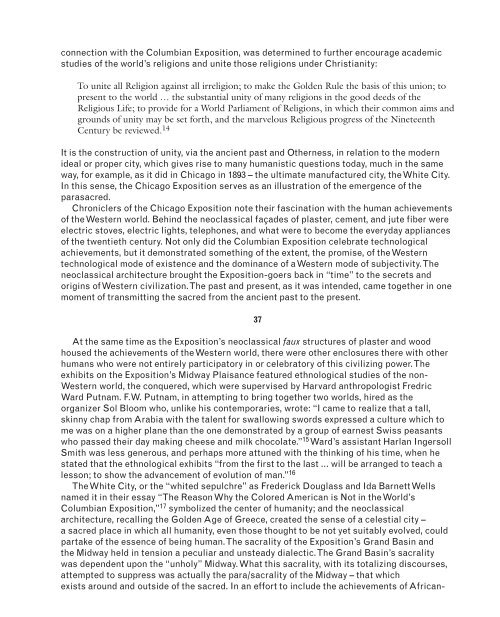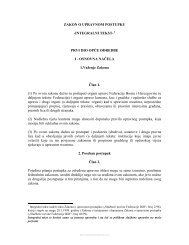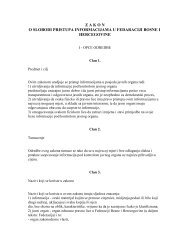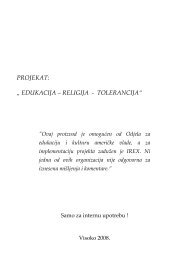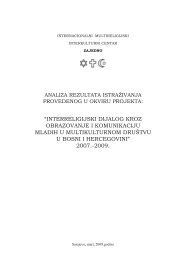connection with the Columbian Exposition, was determined to further encourage academicstudies of the world’s religions <strong>and</strong> unite those religions under Christianity:To unite all <strong>Religion</strong> against all irreligion; to make the Golden Rule the basis of this union; topresent to the world … the substantial unity of many religions in the good deeds of theReligious Life; to provide for a World Parliament of <strong>Religion</strong>s, in which their common aims <strong>and</strong>grounds of unity may be set forth, <strong>and</strong> the marvelous Religious progress of the NineteenthCentury be reviewed. 14It is the construction of unity, via the ancient past <strong>and</strong> Otherness, in relation to the modernideal or proper city, which gives rise to many humanistic questions today, much in the sameway, for example, as it did in Chicago in 1893 – the ultimate manufactured city, the White City.In this sense, the Chicago Exposition serves as an illustration of the emergence of theparasacred.Chroniclers of the Chicago Exposition note their fascination with the human achievementsof the Western world. Behind the neoclassical façades of plaster, cement, <strong>and</strong> jute fiber wereelectric stoves, electric lights, telephones, <strong>and</strong> what were to become the everyday appliancesof the twentieth century. Not only did the Columbian Exposition celebrate technologicalachievements, but it demonstrated something of the extent, the promise, of the Westerntechnological mode of existence <strong>and</strong> the dominance of a Western mode of subjectivity. Theneoclassical architecture brought the Exposition-goers back in “time” to the secrets <strong>and</strong>origins of Western civilization. The past <strong>and</strong> present, as it was intended, came together in onemoment of transmitting the sacred from the ancient past to the present.37At the same time as the Exposition’s neoclassical faux structures of plaster <strong>and</strong> woodhoused the achievements of the Western world, there were other enclosures there with otherhumans who were not entirely participatory in or celebratory of this civilizing power. Theexhibits on the Exposition’s Midway Plaisance featured ethnological studies of the non-Western world, the conquered, which were supervised by Harvard anthropologist FredricWard Putnam. F.W. Putnam, in attempting to bring together two worlds, hired as theorganizer Sol Bloom who, unlike his contemporaries, wrote: “I came to realize that a tall,skinny chap from Arabia with the talent for swallowing swords expressed a culture which tome was on a higher plane than the one demonstrated by a group of earnest Swiss peasantswho passed their day making cheese <strong>and</strong> milk chocolate.” 15 Ward’s assistant Harlan IngersollSmith was less generous, <strong>and</strong> perhaps more attuned with the thinking of his time, when hestated that the ethnological exhibits “from the first to the last … will be arranged to teach alesson; to show the advancement of evolution of man.” 16The White City, or the “whited sepulchre” as Frederick Douglass <strong>and</strong> Ida Barnett Wellsnamed it in their essay “The Reason Why the Colored American is Not in the World’sColumbian Exposition,” 17 symbolized the center of humanity; <strong>and</strong> the neoclassicalarchitecture, recalling the Golden Age of Greece, created the sense of a celestial city –a sacred place in which all humanity, even those thought to be not yet suitably evolved, couldpartake of the essence of being human. The sacrality of the Exposition’s Gr<strong>and</strong> Basin <strong>and</strong>the Midway held in tension a peculiar <strong>and</strong> unsteady dialectic. The Gr<strong>and</strong> Basin’s sacralitywas dependent upon the “unholy” Midway. What this sacrality, with its totalizing discourses,attempted to suppress was actually the para/sacrality of the Midway – that whichexists around <strong>and</strong> outside of the sacred. In an effort to include the achievements of African-
Americans, for example, August 25, 1893 was designated “Colored Peoples’ Day.” Thisparticular day marked, <strong>and</strong> to some extent reaffirmed, the sacrality of the White City byincluding “African-Americans only in the racist space afforded them by white America ingeneral.” August 25 was white America’s “Colored Peoples’ Day,” replete with all the hatredthat late nineteenth-century racism offered. As the gates opened, Puck magazine’scartoonist Frederick Burr Opper provided “Darkies’ Day at the Fair,” a series of caricaturesthat depicted black Americans in the most hateful of racial stereotypes. Ironically, later thatday, amid taunts <strong>and</strong> jeers, Frederick Douglass delivered his famous speech “The RaceProblem in America.” In this speech, Douglass firmly stated that “there is no Negro problem.The problem is whether the American people have loyalty enough, honor enough, patriotismenough, to live up to their own constitution.” 18 It was the “enough” of Douglass’s messagewhich drew out the sense that what is sacred for America, what is ultimate, is incompletewithout the parasacred of black America. The speech called into question the configuration ofthe ideal or proper city <strong>and</strong>, at the same time, the flawed notion that there is but one – shared– world.If one were to have asked the question “What does it mean to be human?” in the context ofthe 1893 Columbian Exposition, the answer certainly would have been “To be white <strong>and</strong>Western.” The “White City,” the “white elephant,” even the “whited sepulchre,” identify thepower of whiteness with civilization <strong>and</strong> humanity. In “The Reason Why,” however, Barnett-Wells <strong>and</strong> Douglass continually point to another experience of the world, one which, at thetime, escaped the categories of the Exposition’s directors. Frederick Douglass, in particular,addresses this notion of the unshared world by pointing to his own former life as a slave inthe South <strong>and</strong> the legacy of slavery that persisted at the Columbian Exposition:38He was a marketable commodity. His money value was regulated like any other article; it wasincreased or decreased according to his perfections or imperfections as a beast of burden.Chief Justice Taney truly described the condition of our people when he said in the DredScott decision, that they were supposed to have no rights which white men were bound torespect. White men could shoot, hang, burn, whip <strong>and</strong> starve them to death with impunity.They were themselves made to feel themselves as outside the pale of all civil <strong>and</strong> political institutions.The masters’ power of them was complete <strong>and</strong> absolute. … So when it is asked why weare excluded from the World’s Columbian Exposition, the answer is Slavery. 19Douglass’s invocation of the horrors of slavery in his text must be read in the context of 1893,at a time when slavery was still very much a part of living memory:The life of a Negro slave was never held sacred in the estimation of the people of that section ofthe country in the time of slavery, <strong>and</strong> the abolition of slavery against the will of the enslaversdid not render a slave’s life more sacred. 20Douglass’s analysis of American culture, through the event of the Columbian Exposition,raises the issue of a nation’s identity. An individual <strong>and</strong> a community are forced into analliance by the impetus to unify differences under the sacred. As Douglass points out, theforming of a unified nation after abolition did not encompass the lives of black Americans.The White City, for Douglass, was more than the Columbian Exposition itself: it was a culturallogic made operational by the instantiation of homogeneous origin <strong>and</strong> telos via sacrality.Just as both Tansey’s listener <strong>and</strong> Mahfouz’s Omar search for individual authenticity
- Page 2: PARA/INQUIRY“For those of us who
- Page 5 and 6: First published 2000by Routledge11
- Page 8 and 9: CONTENTSList of figures ixAcknowled
- Page 10: FIGURES3.1 Questioner of the Sphinx
- Page 14: Posting
- Page 17 and 18: meaning that founds philosophical i
- Page 20: CHAPTER 1Paralogies
- Page 23 and 24: Lyotard’s enjeu, Deleuze and Guat
- Page 25 and 26: In his book Pararealities: The Natu
- Page 27 and 28: acquittal. The horror of the text i
- Page 29 and 30: writer therefore work without rules
- Page 32: CHAPTER 2Parastructures of the sacr
- Page 35 and 36: In this critical space opened by Ni
- Page 37 and 38: Joyce’s Finnegans Wake the exempl
- Page 39 and 40: Deservedly confin’d into this roc
- Page 41 and 42: story of the sacred? Is there but o
- Page 44 and 45: The aspects of things that are most
- Page 46 and 47: AUTHENTICITYThe Sphinx has symboliz
- Page 48 and 49: The fact that I exist and have an i
- Page 52 and 53: through the sacred, so does the com
- Page 54 and 55: appropriation of his thought and of
- Page 56 and 57: use or civil meaning of the word (t
- Page 58 and 59: does not mean that one is sidestepp
- Page 60: of the twentieth century. As Lyotar
- Page 64 and 65: The sacred of the archaic world was
- Page 66 and 67: possibility for an expression of ex
- Page 68 and 69: the actual frame of the panels, the
- Page 70 and 71: space of the painting, and, second,
- Page 72 and 73: much a part of scholarship today. A
- Page 74 and 75: not merely interesting footnotes to
- Page 76 and 77: many to see Eliade as a mystic who
- Page 78 and 79: phenomenology. Eliade’s arrival i
- Page 80 and 81: of the sacred as a child in Romania
- Page 82 and 83: discursive structure to relinquish
- Page 84 and 85: autonomy of the work of art. But ha
- Page 86: CHAPTER 5Para Shoah
- Page 89 and 90: Faurisson reveals that the Shoah is
- Page 91 and 92: MEMORIES OF FORGETTINGCertainty is
- Page 93 and 94: political. Each of these ground(ing
- Page 95 and 96: totalizing discourses or a determin
- Page 97 and 98: Kantian wound often move toward a q
- Page 99 and 100: Secret fauna and flora which the re
- Page 102:
CHAPTER 6Parasacred ground(ing)s
- Page 105 and 106:
often exist outside (the pagus) the
- Page 107 and 108:
graveyard. The sacred disfigures,be
- Page 109 and 110:
death, which is another repetition
- Page 111 and 112:
able to choose from a range of poss
- Page 113 and 114:
eligious. Mary’s presence as a mi
- Page 115 and 116:
As one walks through a cemetery, ti
- Page 117 and 118:
104Figure 6.15b Clinging to the Cro
- Page 120 and 121:
To think not is to linger with a ne
- Page 122 and 123:
PARASACRED IMAGESNor does one need
- Page 124 and 125:
irreverent piety in so far as eachr
- Page 126:
CHAPTER 8EpilogueParaultimacy
- Page 129 and 130:
The steps, the corridor, to the plo
- Page 131 and 132:
GLOSSARYI should say that in so far
- Page 133 and 134:
The early writings of the French ph
- Page 135 and 136:
NOTESPOSTING1 Michel Montaigne, Apo
- Page 137 and 138:
metaphysical notion of effectivespa
- Page 139 and 140:
and probably goes back to helios.Ea
- Page 141 and 142:
“compensate” the rigidity of th
- Page 143 and 144:
GLOSSARY1 Peter A. Angeles writes(H
- Page 145 and 146:
Stanford: Stanford University Press
- Page 147 and 148:
Riverside Shakespeare edn, Boston:H
- Page 149 and 150:
Carroll, Lewis 23cemeteries 93, 101
- Page 151 and 152:
painting 58; laughter as epiphany 5
- Page 153 and 154:
“paraexperience” 83, 86; the po
- Page 155 and 156:
postmodernism: authenticity 33;ceme
- Page 157 and 158:
Thousand Plateaus, A (Gilles Deleuz


